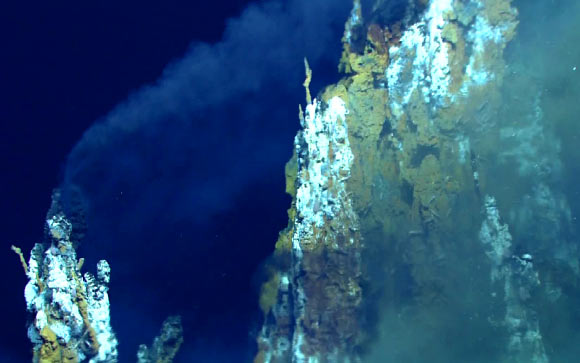According to a team of biologists led by Dr Gregory Dick from the University of Michigan, at deep-sea hydrothermal vents in the western Pacific, previously unknown viruses infect bacteria to get tiny globules of sulfur stored inside the bacterial cells.

Hydrothermal vent in the Lau Basin, the western Pacific Ocean. Image credit: MARUM / University of Bremen / NOAA-Pacific Marine Environmental Laboratory.
Similar virus-bacteria interactions have been observed in shallow ocean waters between photosynthetic bacteria and the viruses that prey on them. But this is the first time such a relationship has been seen in a chemosynthetic system, one in which the microbes rely solely on inorganic compounds, rather than sunshine, as their energy source.
Dr Dick and his colleagues collected water samples during trips to the Eastern Lau Spreading Center in the Western Pacific and the Guaymas Basin in the Gulf of California.
An unmanned submarine collected the samples at a depth of more than 1,800 m, near hydrothermal vents spewing mineral-rich seawater at temperatures over 260 degrees Celsius.
Back in the lab, they reconstructed viral and bacterial genomes. In addition to the common sulfur-consuming bacterium SUP05, the biologists found genes from 5 previously unknown viruses.
The genetic data suggest that the viruses prey on SUP05.
That’s not too surprising, since viruses are the most abundant biological entities in the oceans and are a pervasive cause of mortality among marine microorganisms. The real surprise is that the viral DNA contains genes closely related to SUP05 genes used to extract energy from sulfur compounds.
When combined with results from previous studies, this finding suggests that the viruses force SUP05 bacteria to use viral SUP05-like genes to help process stored globules of elemental sulfur. The SUP05-like viral genes are called auxiliary metabolic genes.
“Our findings suggest that viruses in the dark oceans indirectly access vast energy sources in the form of elemental sulfur,” said Dr Dick, who is the senior author of the paper published in the journal Science.
The findings will help researchers understand how marine biogeochemical cycles, including the sulfur cycle, will respond to global environmental changes such as the ongoing expansion of dead zones.
SUP05 bacteria, which may generate the greenhouse gas nitrous oxide, will likely expand their range as oxygen-starved zones continue to grow in the oceans.
______
Karthik Anantharaman et al. Sulfur Oxidation Genes in Diverse Deep-Sea Viruses. Science, published online May 01, 2014; doi: 10.1126/science.1252229







